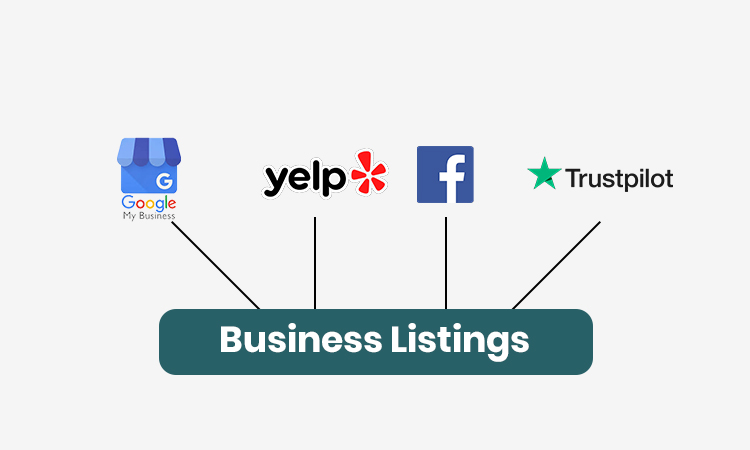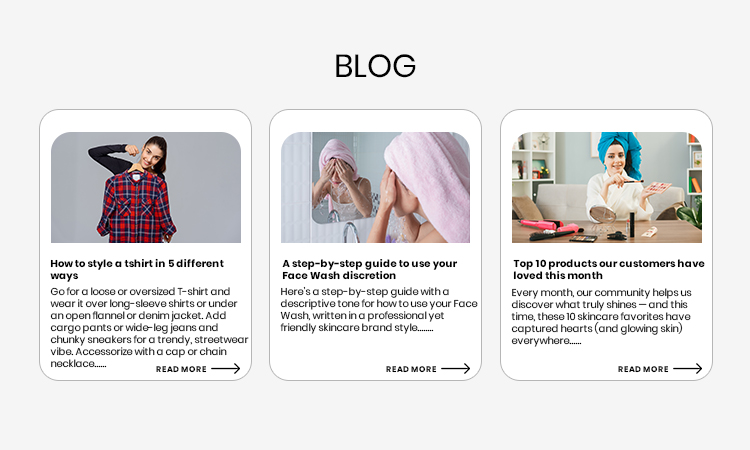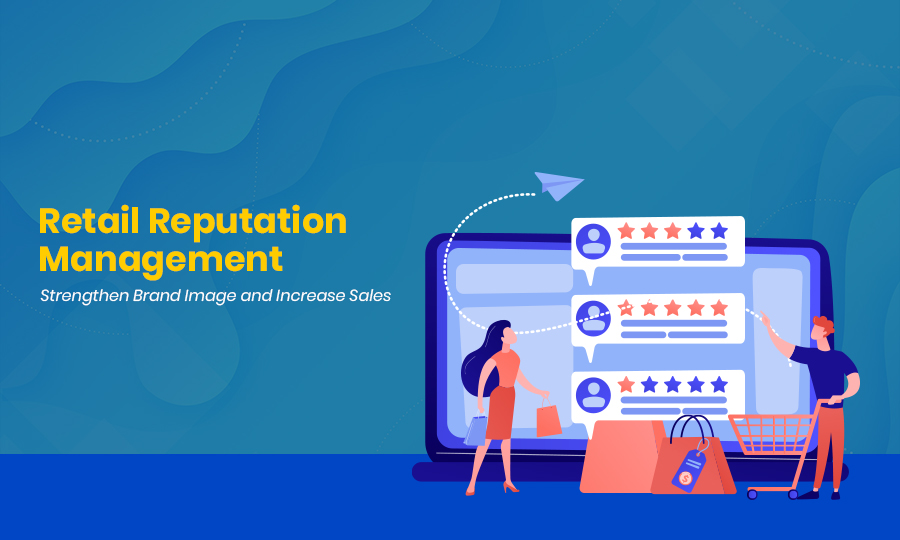What’s worse than having a poor online reputation for your retail companies? Ignoring it. Yes, you heard that right. If you run a retail business with a poor online image and you’re doing nothing about it, you may lose sales to your market competitors. A poor online reputation and an invisible digital presence can cost you your entire business. Whether you have a local shop, an online store, or a global brand, retail reputation management is a non-negotiable marketing technique for you.
Do you know that 81% shoppers research products online before purchasing them?
Today’s customers are vocal, and their reviews can actually make or break your retail business. Shoppers now highly rely on fellow customers’ real experiences and are interested in the comments and opinions they have shared about the store.
This is what builds the reputation of the retail company – shaping consumer behavior and determining future sales. Even a single negative review or news story can damage your retail business’s digital image beyond repair.
Therefore, it’s best to adopt a strategic approach from the outset. Want to know more about effective online reputation management for a retail company? In this blog, we’ll provide you with all the strategies and techniques you need to thrive in the retail industry.
What is Retail Reputation Management?
It refers to the process of managing and influencing what the online users perceive about a retail business through its online presence. In simple words, it’s about building and maintaining a retail brand’s positive public image across various digital platforms.
What does it include? It’s an ongoing process; from actively monitoring customer reviews and social media sentiment to optimizing local business listings, the process involves some key activities to establish a positive brand image of a retail business.
A positive retail business’s reputation encourages more potential customers to purchase from that specific store and drives exceptional sales. An online reputation monitoring agency helps retail brand owners take control of what the digital world sees, thinks, and experiences when communicating with their business.
For a retail business, success depends not only on the business owners’ and teams’ ability to promote and sell their products but also on the customer trust the retail brand has built so far.
Why Reputation Matters in the Retail Sector: 6 Key Reasons
In today’s fast-paced digital world, information about a retail brand, the products it sells, and the quality of its customer service is readily available at consumers’ fingertips. A majority of people who seek good products actively search online for a reliable retail store.
So the fact is – if your retail brand doesn’t appear with a positive image in those online searches, you may struggle to grow your customer base.
In the past few years, the retail industry has witnessed major transformations due to the increasing popularity of e-commerce platforms and technological advancements. The competition is fierce, and you can’t deny that! That’s what makes building a stellar online reputation more crucial for retail brands.
Let’s unfold the reasons why reputation matters in the retail sector.
- Impacts on Sales and Conversions
What will a consumer see first while choosing a retail brand to purchase products from? It’s the brand’s reputation. Retail stores with a positive online image highly influence consumers’ purchase decisions.
Similarly, a negative reputation can deter your prospects. According to Moz, if a business has four or more negative articles about itself online, it is more likely to lose almost 70% of potential customers. What the digital world shows about your retail business – this is what determines your future sales and conversions.
- Consistent Brand Identity across Channels
If you want your retail brand to thrive in the digital world, you must prioritize consistent branding and messaging across all online touchpoints. A good reputation ensures a consistent visual brand identity of your retail business across channels, including review sites, social media platforms, search engine result pages, and local online directories.
On the other hand, a poor online image can lead to an inconsistent brand identity, which may confuse customers and erode their trust.
- Effects on the Digital PR Crisis Prevention
Proactive retail reputation management techniques ensure a robust digital image for your retail business. Reputational crises can occur at any time, sometimes even without any sign. When you have a good digital reputation, your retail brand gets brownie points during such a digital PR crisis. Imagine that someone has complained about poor product quality, or an old, negative news article has gone viral on the internet.
If you already have a good reputation and several satisfied customers, they will advocate for your retail brand on your behalf. This way, you can prevent a PR issue from becoming a full-blown digital crisis.
- Creates a Competitive Advantage
A strong reputation can differentiate your retail brand in a crowded marketplace and provide a competitive edge over competitors. It can set your expertise apart in an industry where products are similar across brands.
Retail brands with a good reputation position the retailers as trusted experts and build strong authority. Another crucial benefit of having a positive online reputation is that you can attract talented job seekers and potential business partners.
- Better Online Visibility
A good reputation for a retail business improves its search engine visibility for relevant online queries. Search engines like Google prefer to rank retail businesses with a good reputation in their search results.
The more glowing reviews and higher rankings your retail business has, the more chances you get to make your retail business visible across digital platforms. When your retail business consistently appears in search results and on other digital platforms, it significantly increases your brand awareness.
- Boosts Financial Performance
As a retail business owner, your reputation financially impacts your retail business growth.
While a positive reputation boosts your sales and revenue, a poor digital image can have a severe impact on your retail store’s financial performance. Many consumers may not purchase products from your brand, resulting in a significant loss of sales opportunities.
So, a brighter online reputation comes with higher profit margins. Additionally, your satisfied customers will advocate for your retail brand and refer it to their family and friends. Word-of-mouth recommendations reduce your marketing costs as well.
- Ensures Client Acquisition and Retention
A retail business’s reputation is all it takes to attract new customers and retain customers. When consumers actively seeking good products online come across your retail brand and see its positive digital image, they get influenced to consider your brand for purchasing products.
A strong digital reputation is a marketing material that drives trust and brand credibility. Just as it helps in customer acquisition, it also plays a huge role in building long-term customer relationships, fostering their loyalty, and ensuring repeat purchases.
Step-by-Step Guide to Building and Managing a Retail Reputation Management
Now that you know how a good reputation can benefit your retail business, it’s time for your business to get proactive. Retail business owners need to implement personalized strategies to build and effectively manage a stellar reputation online to use it as a tool to improve and grow.
Effective online reputation management (ORM) requires a strategic approach to ensure extraordinary outcomes. The next section will explain a comprehensive step-by-step guide on expert ORM for retail businesses. Let’s get started.
Step 1: Audit Your Current Brand Reputation

The first step is to know where your retail business’s reputation currently stands.
It’s where you need to get started! Without a proper understanding of your retail brand’s reputation, you cannot tailor your ORM strategies based on your brand’s reputational needs. The following are three crucial strategies to audit your current brand image.
- Google Your Brand Name
Google is one of the most popular search engines, accounting for 89.66% of the global search engine market. To understand your retail brand’s reputation, you need to perform a detailed search on Google.
- Search for your brand’s name on Google’s search bar to see how it appears in the search results.
- Now, closely observe the information appearing in the search snippet – the specific part of the search engine result pages (SERPs) your consumers will interact with at first. If you have an online retail company, you can Google its name to check the online store’s reputation.
- Track Your Profiles on Online Review Sites, Google Business Profile, Facebook, and Yelp
Apart from Google, you need to check the third-party review sites, Google Business Profile, and social media platforms.
- Track whether your GBP and Yelp listings have accurate information about your retail brand.
- Check if the NAP details are correct and consistent across all platforms, including the hours of operation, holiday hours, and website links.
- Note the type and volume of reviews you’ve received so far – are they positive, negative, or neutral?
- For social media, track the conversations, comments, and brand mentions to identify what your customers perceive about your retail brand.
- Identify Outdated or Irrelevant Content
The last part of auditing your brand image is to find if there is any outdated information or irrelevant service details. If any, remove those inaccurate details and update the correct ones.
Here are some elements that mustn’t be outdated or irrelevant in your listings.
- Old or unprofessional photos that don’t represent your retail store
- Old posts about products that your retail store no longer sells
- Outdated information with no reference to your current company details
- Incorrect links that lead to incorrect pages
Step 2: Claim Your Local Business Listings

This is another crucial retail reputation management strategy.
Do you have profiles on popular business directories?
If not, it’s important to create one with all the essential details of your retail store. From Google Business Profile, Yelp, and Trustpilot to social media platforms like Facebook, a retail store must have its business listings on every important directory.
5 Listing Platforms Retail Businesses Must Consider
Here are the 5 most popular business listing platforms that retail businesses must have a profile on.
- Google Business Profile (GBP)
A huge number of consumers prefer searching on Google to find a local business.
- As a retail business owner, you must optimize your GBP profile with accurate and consistent NAP details, such as name, address, and phone number.
- You need to add the business hours, website URL, photos, and a compelling description about your products. A Google study has claimed that customers are 50% more likely to consider purchasing from a business with a complete GBP profile.
- A well-optimized GBP profile will help your retail business become more visible in Google Maps and local searches.
- Yelp
An important step in performing reputation management for retail companies is to create a Yelp listing. It’s a must for brick-and-mortar retail stores serving multiple locations.
- Yelp features photos, reviews, and business information, along with details of check-ins.
- You can receive customer reviews on Yelp as well. Managing Yelp reviews strategically is crucial to grow a retail brand’s online customer base and effectively promote its products.
- When you have a well-optimized Yelp profile with glowing reviews, it improves your retail business’s reputation.
Facebook is one of the most popular social media platforms, which has a wide reach globally. For customer engagement and targeting a specific audience base, retail business owners must prioritize listing their business on Facebook.
- Your business page on Facebook displays your business hours, product catalog, reviews, contact details, location, and even your social media posts.
- You can have direct conversations with your followers through Facebook direct messaging.
- Your customers can share recommendations about your retail business.
- You can even use the feature of Facebook Shops to promote your products to your Facebook community and sell them online.
- Trustpilot
It’s primarily a popular third-party review platform where a retail business owner can manage their customer feedback and build a strong digital image. Retail brands must manage Trustpilot reviews to use them as impactful marketing materials.
- Trustpilot offers a ‘TrustScore’ feature that aggregates customer reviews.
- Big retail enterprises can opt for the paid plans and leverage tools to automate review invitations.
- They can also display Trustpilot widgets on their official website to showcase their glowing reviews and a good reputation.
- This platform features reviews submitted by only verified reviewers, making it a reliable source for customer feedback.
4 Proven Strategies to Optimize Your Retail Business Listings
Want your business listings to speak volumes about your retail business’s professionalism? Let’s have a look at some crucial strategies to effectively optimize your retail business listings.
- Add Your NAP Details and Maintain Consistency – Don’t forget to add the name, address, and phone number of your retail store. Ensure to keep the details consistent across online platforms, like the website, social media, and review sites. Add a category of your business, such as a ‘retail company’ or an ‘online retail store’.
- Include High-quality Photos and Videos – You can invest in high-resolution photography and video production for your website, social media platforms, and product pages. From ‘how-to’ tutorials to product demonstrations and video testimonials, you can share high-quality photos and videos on your business listings.
- Incorporate Professional Bios and Compelling Business Descriptions – Write a compelling description of your retail products and other USPs of your brand. Additionally, retail business owners can craft an informative ‘About Us’ section to showcase their journey of establishing a brand, how they build their team, their company mission, and more. Create professional bios for your key personnel, their expertise, academic achievements, and work experience.
- Showcase Your Awards and Certifications – On your business listings, you can showcase your awards and other special certifications to showcase your retail brand’s authority. When your prospective customers interact with your business listings, they will feel more encouraged to purchase from your brand, seeing its achievements.
Step 3: Develop a Review Management Strategy

Effective customer review management is another crucial retail reputation management strategy that can prove to be a game-changing idea. A strategic approach to generating, managing, and handling customer reviews helps build trust and improve a retail company’s reputation both online and offline.
Several glowing reviews for your retail company showcase your business’s reliability in the virtual world. A 2025 Brightlocal study has shown that 74% of consumers check at least two review sites before making a purchase decision. Let’s unfold the secrets to strategic customer review management for retail companies.
- Collect New Reviews from Happy Customers
Here are some helpful ideas to collect new reviews from your happy and satisfied customers.
- Just ask without any pressure: The most beneficial strategy to generate genuine reviews from your existing customers is to just ask for them. Yes, a glowing review is just a nudge away! Many of your loyal customers may not share their experience if you don’t ask for it – even if they have a good experience purchasing from your retail store.
- Maintain an optimal timing: When you’re asking for a review, timing matters the most. You must send a review request within one week of a successful purchase, especially when the positive experience is fresh in the customer’s mind. Requesting reviews after one month of a purchase may not impact the customer.
- Consider in-store requests: You must train your staff to politely ask the customers for a review at the checkout counter. Additionally, they can send automated post-purchase emails and SMS messages with a direct link to your review profile. However, you shouldn’t ask for reviews immediately after a product purchase; it’s essential to give the customers proper time to use the product.
- Simplify the process: Another way is to use a business card or printed note with a QR code on the product packaging. This will simplify the process for your customers to submit a review on the right platform.
- Professionally Respond to Positive and Negative Reviews
Once you receive the reviews, it’s time to respond to them professionally. Expert business for retail business involves framing strategic responses to customer reviews of all types.
- Respond to every review: As a retail store owner, acknowledging every time of review is your responsibility. Responding to all reviews shows that you value customer satisfaction and customers’ opinions.
- Respond promptly: Always aim to respond within 24-48 hours of receiving a review. Do you know that 53% of customers expect companies to respond within a week to negative reviews?
- Tailor your response: Always address the reviewers by their name and avoid using generic language. You must also mention the specific details highlighted in the review to offer a genuine response.
- Express gratitude for positive customer reviews: Don’t forget to express your gratitude for the positive customer feedback. Thank them for the business you have made and build loyalty with them. Request them to visit your store and showcase how eager you are to serve them soon with some amazing products.
- Apologize and offer a solution for negative reviews: Keep calm while responding to negative feedback. If the mistake is on your end, you must apologize sincerely to the customer through a review response. Try to offer them a suitable resolution as soon as possible to turn the negative customer experience into a positive business opportunity.
Note: If things get escalated, you can choose to handle things offline by requesting the customer contact your team personally.
- Promote Your Glowing Customer Testimonials on Website and Social Media Profiles
No matter how many positive online reviews you have received, if you don’t promote them well, your consumers will not know how much your customers have loved your products. You can create a dedicated page for ‘Testimonial’ or add a review widget on your home page, where you showcase your glowing reviews and star ratings.
- Social media shout-outs: You can repurpose text or video testimonials into visually appealing graphics or short videos for social media channels like Facebook, Instagram, and TikTok.
- Ask for permission: Before sharing user-generated content like testimonials, you must obtain permission from your customers. Additionally, you can feature them on your social media feed or stories if your customers agree.
- Print and post in your store: If you have an offline retail store, you can print your glowing reviews and showcase them on the walls of your store.
- Handle Fake Reviews like a Pro
Reputation management for a retail company requires you to actively monitor online reviews. When you mindfully monitor your online reviews, you can seamlessly identify fake reviews.
Major Signs of Fake Reviews
Search for the following signs to detect a fake review –
- Vague and generic language
- Lack of specific details
- Sudden increase in negative reviews
- User profile with no picture
- User profile with limited history
- Fake claims or irrelevant information
- Promotion of competitor products
- Extreme emotions/poor grammar
- Repetitive phrases
- Sales-pitch language
Tips to Handle Fake Customer Reviews
- Document everything: You must take screenshots and collect any evidence to prove that the review is not genuine.
- Report the review: If a fake review is harming your retail business reputation, you must report that review. Click on the three dots present in the right upper side of the review and select ‘Report Review’ or ‘Flag as inappropriate’. After that, select the reason to mention why you want to report the specific review. Submit your request after filing the form completely.
- Respond publicly: You must respond to the fake reviews. For example, if you don’t respond to a fake review that mentions negative aspects of your retail business, your potential customers may perceive those aspects as true. Acknowledge the review by stating that you haven’t found any details of the reviewer as a customer, and ask the person to get in touch with your team personally.
- Seek legal help: You must seek legal assistance if the reviewer doesn’t agree to delete the review. If the fake review is damaging your retail store’s reputation, we suggest you consult with a legal professional.
Have more doubts? Seek professional online review management services from a reputable agency.
Templates for Responses to Positive, Negative, and Fake Reviews
For Positive Reviews:
“Hey (customer name), we’re happy to know that you had a great experience at our store and you loved our products. Your feedback means a lot to us; we’re eager to serve you with some exciting products soon. Don’t forget to visit our store during the Christmas festival to get your hands on some unbelievable offers.”
For Negative Reviews:
“Hey (customer name), thank you for taking your time to share your valuable opinions. We’re sorry to hear that you’re disappointed with (product name). We would like to inform you that this is not the standard our retail store strives for. We apologize for the inconvenience caused and are looking forward to offering you a resolution soon.”
For Fake Reviews:
“Hi (customer name), thank you for sharing your feedback. However, we would like to inform you that we don’t have a record of a customer named as you and the details of the purchase mentioned. However, we want to investigate the issue further and need more details for this. If you have visited our store and have the billing invoice, please send it to (email address) with more details of your purchase.”
Step 4: Encourage Positive Customer Engagement

Customer engagement is crucial for making your retail customers into brand advocates. After a successful purchase, your responsibility doesn’t end here. You need to keep the customers engaged throughout the time, even when they’re not purchasing anything from your retail store.
From organizing loyalty programs to promoting user-generated content and offering incentives, you can engage your customers.
Prioritize Loyalty Programs and User-generated Content
These are some beneficial ways to engage your customers.
- Loyalty programs
As a crucial retail reputation management strategy, you can organize loyalty programs for your customers for better engagement. It will encourage repeat purchases and ensure customer loyalty.
Here’s how you can plan your loyalty programs.
- Structure your loyalty program with different levels like Bronze, Silver, and Gold for existing and new customers. When your new customers level up the tier by purchasing more from your retail store, they will unlock more exciting rewards.
- Those customers with Silver and Gold loyalty programs can get exclusive perks beyond simple discounts on products.
- You can also offer exclusive perks like invitations to your in-store events and access to early product releases.
- Offer reward points for leaving reviews, referring your retail company, or following your social media business page.
- Ensure the loyalty program is available on your retail store’s mobile app.
- User-generated Content
Do you know that your customer testimonials serve as social proof for your retail business?
- Create hashtags based on your retail brand, such as #MyStoreStyle, #HappyCustomers, or #LovedReceivedforXYZStore.
- Run photo contests and incentivize your customers to share your website or social media content with gift cards, free products, or a feature on your social media page.
- After getting consent, you can share your happy customers’ photos with their purchased products and reviews on a digital screen in your store and the ‘Customer Favorites’ board.
Step 5: Leverage Personal Branding

As a retail brand owner, you must prioritize personal branding strategies. Without solid branding, you cannot establish your retail business as authoritative in the online world as well as in the retail industry. The following are some of the exclusive strategies to solidify your personal branding.
- Design a Memorable Logo
Keep the logo simple so that people can easily recognize and remember it. Don’t clutter the logo with too many elements and make it unique from your market competitors. You must choose colors that evoke the right kind of emotions, aligning with your brand. Choose a font that perfectly complements your retail brand’s personality.
- Discover Your Brand Identity
Firstly, understand your brand’s strengths, passions, target audience, and goals that make your retail business unique in the industry. Your brand identity must be based on your brand’s core values and unique selling points.
Ask yourself the questions –
- How do you solve issues?
- How do you fulfill the requirements of your potential customers?
- Is your brand persona approachable, playful, or confident?
- How do your brand’s core values translate into your brand?
- Tell Your Journey
Through content creation, you can tell your journey of building a retail store from scratch. Develop personalized content (e.g., blog posts, articles, and videos) to showcase your industry knowledge, expertise, and other insights. However, you must stay genuine and maintain transparency while communicating your retail brand’s journey.
- Craft Your Brand Messaging
Retail business owners must communicate their value propositions and key brand messaging compellingly. Try to avoid using jargon and technical terms; customize your messaging to your specific target audience. Don’t forget to add an encouraging call to action (e.g., ‘Visit us today’, ‘Check our website’, ‘Subscribe to our newsletter’, ‘Contact us today’) to influence your consumers to take necessary actions.
- Decide on a Theme, Font, and Color Code that Suits Your Brand Identity
For a theme, font, and code, you must choose the elements that align with your brand personality and the aesthetic. Try to choose a minimalist theme or a vibrant one based on your brand persona. Additionally, the font should complement your brand theme and reflect your brand message. For your official website, retail brands can choose a color palette that also aligns with their brand values and emotions.
Step 6: Develop High-Quality Content to Build Authority

Content plays a huge role in establishing an authority in the virtual world, as it’s the first thing your consumers will interact with after searching your brand name on Google. Retail brand owners must develop high-quality content and implement content marketing techniques as follows.
- Create a Content Calendar
Retail brand owners must plan different content themes based on seasonal trends – new product launches, holiday sales, and closing hours. It will help you publish consistent and timely content.
- Choose High-Impact Channels
You should focus on visually-driven online platforms like Facebook, Instagram, Pinterest, and the like, where you can showcase and promote your products and ensure immediate engagement.
- Create Informative and Engaging Videos
According to a 2024 HubSpot report, 50% of marketers prefer to leverage video content for their marketing strategy. You can invest in professional videographers or editors to create engaging video materials on your retail products. For example, if you have a readymade clothing retail store, you can create videos on clothing tutorials, lifestyle shots, styling tips, and behind-the-scenes looks to engage more shoppers.
- Leverage Visual Content like Images and Infographics
Retail reputation management strategies require you to develop short videos for YouTube Shorts and Instagram Reels, along with eye-catching images and infographics. Always utilize high-quality product images and simple infographics for marketing purposes. Some ideas are to create size charts in a table-like shape or how-to-care guides for your products.
- Publish Blogs on Website
Looking for a platform where you can showcase your retail knowledge? It’s on your own official website. Develop a separate section for ‘Blogs’ on your website and publish regular blog posts on different topics to inspire shoppers’ confidence in your retail brand.
- How to style a (clothing name) in 5 different ways
- A step-by-step guide to use our (skincare product name)
- Product of the week
- Best features you’ll find in (product name)
- Top 10 products our customers have loved this month
- Product success stories
- Employee features
- Must-have summer-friendly items you’ll find in our store
- 5 latest trends in western clothing in 2025
- Expert interviews
- Post Interactive Content on Social Media
This type of content can engage more consumers and customers. You can engage new and your existing customers with interactive polls, quizzes, and ‘ask me anything’ sessions. You must organize such virtual sessions on different social media platforms like Facebook and Instagram. This way, you can effortlessly understand public sentiment about your business and gather feedback directly.
Step 7: Deal with Retail Reputational Crisis
A retail business’s reputation is quite fragile; a reputational crisis can occur at any time. Developing a robust plan to deal with such a crisis can help retail brand owners prevent major reputational damage.
An effective online reputation crisis management strategy involves the following best practices.
- Address Issues Publicly – Retail brands must publicly address customer concerns and showcase the steps they have planned to take to resolve the issue. It will show your commitment to delivering the best possible services for your customers. We suggest you publish a public statement if it’s related to a digital PR crisis.
- Offer a Sincere Apology if Necessary – If the mistake is on your end, you must make a sincere apology for the inconvenience your customers have faced. A little ‘sorry’ can go a long way beyond defensive communication.
- Publish More Positive Content – We’ve already talked about how positive and high-quality content can build your brand authority. You can follow our strategies to create engaging content to improve your online reputation.
- Focus on Offering a Suitable Resolution – Always try to offer a suitable solution to your customers as soon as possible when the crisis is still relevant. Otherwise, a resolution may not create many differences in your customers’ perception of your retail brand.
- Learn from Your Mistakes – Crises occur; mistakes happen. But if you continue making the same mistake repeatedly, it may leave a strong, bad impression of your brand on your customers. And no best practices will work in your favor! Learn from the mistakes and try not to repeat them in the future.
Step 8: Monitor Your Retail Business’s Reputation

Now that you already have a proactive strategy for reputation management for retail companies, it’s time to know how you monitor the reputation and maintain consistency.
Building a positive reputation for one day is not enough; you need to maintain the online image in the long term. Here’s how you can do it –
- Set Up Alerts for New Reviews and Mentions
You can use tools like Google Alerts to track the new reviews, social media mentions, and your retail brand-related keywords through email or SMS notifications. This way, you’ll never miss an opportunity to interact with your customers and offer prompt responses.
- Track Social Media Conversations
There are also some social listening tools that you can use to track your brand’s social media conversations and mentions across Facebook, Instagram, Twitter (X), and LinkedIn. These tools will help you identify your customer sentiment and latest trends.
- Track Key Performance Indicators (KPIs)
Let’s have a look at the KPIs that you need to measure to track your brand’s performance in terms of online reputation.
- Engagement Rate: How much your audience interacts with your retail brand through your website, social media profiles, and online review sites
- Reach and Impressions: The views, likes, comments, and shares on your social media content
- Click-through Rates: How effective your website and social media content are in driving traffic
- Conversion Rates: the percentage of your users who have purchased from your retail store
- Follower Growth Rate: How quickly your target audience on social media has increased
- Return-on-Investment (ROI): How is the profile margin of online reputation management effort
5 Helpful Tools to Monitor Your Retail Brand Reputation Effortlessly
The following are the top 5 tools that retail business owners can employ to make their retail reputation management a little easier and convenient.
| Tools | Features to Use for Reputation Management |
| 1. Hootsuite | ● Manages multiple social media accounts from a single dashboard ● Monitors brand mentions, keywords, and topics ● Consolidates public comments and direct messages |
| 2. Mention | ● Offers real-time monitoring features ● Analyzes the tone of brand mentions ● Sends real-time notifications for new social media mentions |
| 3. ReviewTracker | ● Collects reviews from 100+ online review sites ● Offers real-time alerts for new reviews ● Can help in generating personalized review requests |
| 4. Reputology | ● Monitors and responds to reviews across sites and the retail industry-specific platforms ● Assigns reviews to team members and tracks resolution status ● Provides reports on average ratings and review volume |
| 5. Google Business Manager | ● Creates, verifies, and manages your Google Business Profile information ● Offers free services like review and rating management ● Boosts your retail brand’s local search visibility and customer engagement |
FAQs
Ans. If you have a trained and skilled online reputation management team, you may not need to hire a professional ORM agency. If not, you must prioritize hiring a reliable and renowned agency to seek their expert guidance. Choosing a suitable ORM partner for your retail business is a strategic investment; you can build and protect your brand image from potential risks. The right team will understand your reputational needs and develop personalized strategies to meet your requirements. They will also use their proven expertise and employ useful tools to implement those strategies – this is the factor your in-house team may lack.
Ans. Every negative review mustn’t be fake. Fake reviews have specific and unique patterns that you need to detect to identify fraudulent or irrelevant feedback. Your real customers can also share their negative experience at your retail store. That doesn’t mean those reviews are fake. To identify fake reviews, you need to look for generic, overly promotional, and abusive language. Apart from them, reviews with poor grammar, wrong spelling, vague details, clustered posting dates, and promotions for competitor brands are more likely to be fake. Genuine reviews mostly talk about real experiences of customers and include specific details of a product or service.
Ans. You need to develop a personalized crisis management strategy and implement a multi-channel monitoring system. You need to actively listen to your brand’s online and internal conversations to identify the early warning signs. Situations like negative social media mentions, a sudden rise in negative reviews, a drop in sales, or an increased number of product complaints are some signs of a future reputation crisis. Don’t ignore it; start preparing a strong crisis management plan.
Conclusion
If you’ve thoroughly explored this blog, you now have a clear idea of where to start with retail reputation management. Whether you have a retail start-up or run a global retail enterprise, you must prioritize implementing online reputation management strategies.
Managing the online reputation of a retail business is a critical process. By implementing the mentioned ORM strategies and following the best practices, you can positively shape your brand reputation online.
Do you lack an in-house ORM team that can effortlessly handle your retail brands’ reputational needs? If yes, we suggest you seek professional services from an online reputation management agency that provides tailored services. Explore the market and choose the best ORM partner for your retail brands – this investment can take your business to new heights.

